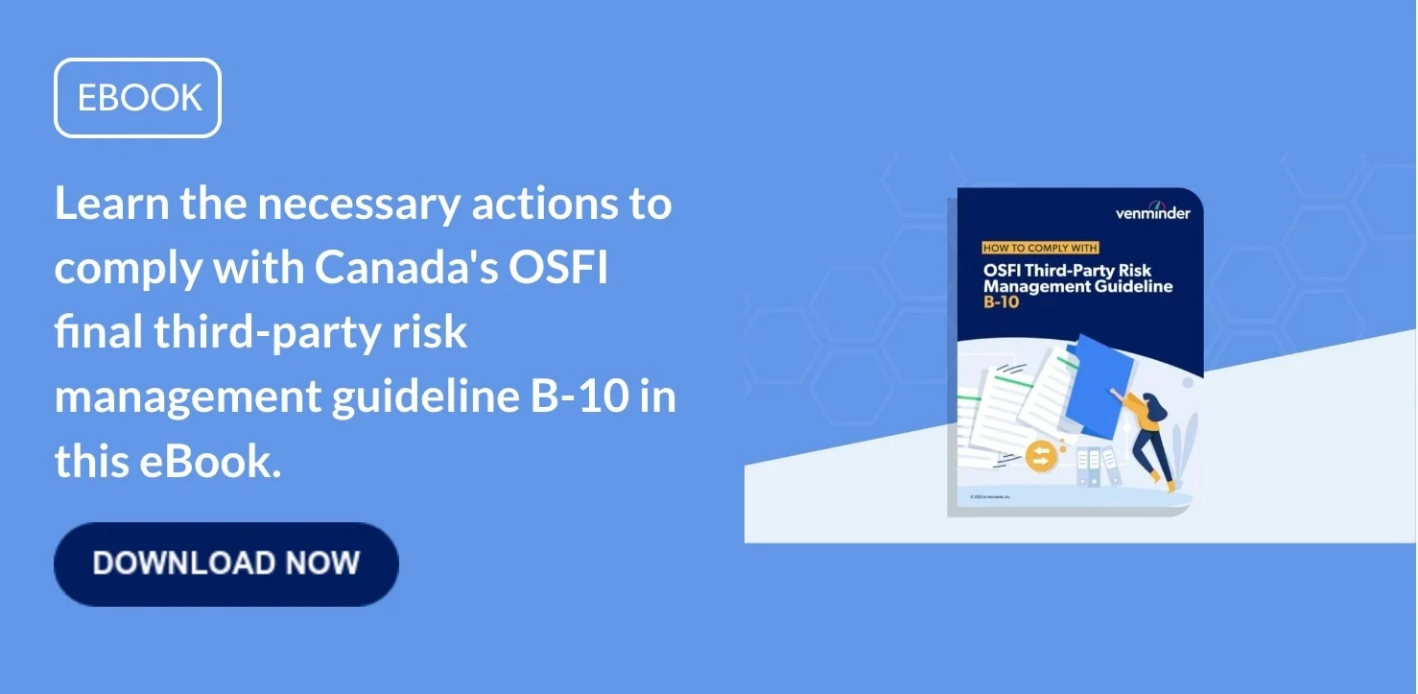Chances are if you're in charge of third-party risk management at one of Canada’s federally regulated financial institutions (FRFIs), you’re already familiar with the Office of the Superintendent of Financial Institutions’ (OSFI) Third-Party Risk Management Guideline, B-10. This is referred to as "the Guideline" throughout this blog. It outlines the requirements for handling third-party relationships and brings a more balanced and practical third-party risk management approach.
Key Components of the OSFI Third-Party Risk Management B-10 Guideline
The final B-10 Guideline reflects feedback from industry leaders, third-party providers, and others gathered during a five-month consultation period in 2022. During that time many expressed concern that the scope of the draft Guideline was too broad and that the expectations for some third-party arrangements could be too burdensome. OSFI revised the final B-10 Guideline in response to those concerns.
Here are some highlights of the key changes:
- Adjustment period – While the final Guideline was released on April 24, 2023, it does allow for a transition period. FRFIs can adjust to new norms, ensure smooth implementation, and lessen disruption and confusion.
During this transition period, FRFIs should:
Any third-party relationships that begins on or after May 1, 2024, must follow the Guideline. Third-party relationships already in place must be reviewed and updated at the first contract renewal or amendment opportunity to align with the Guideline's expectations.
- Less prescriptive language – The B-10 Guideline adopts a more flexible approach to due diligence and written arrangements. It prioritizes risk assessments and allows FRFIs to customize their due diligence according to the unique risk profiles.
- Overlap resolution – The B-10 Guideline provides clarity on how its expectations align with other guidelines, minimizing confusion for FRFIs. It encourages consistency and collaboration among regulators, as the Guideline complements regulatory guidance from other agencies.
- Scope – The B-10 Guideline’s scope applies to significant arrangements that may pose material risks. A third-party arrangement is any business or strategic agreement made between the FRFI and an entity or individual, regardless of whether it’s contractual or not. This excludes any agreements made with FRFI customers, such as depositors, policyholders, and employment contracts.
- Subcontractor management – The B-10 Guideline addresses the importance and challenges of subcontractor management, also referred to as fourth-party management. FRFIs should align subcontractor management with the risk level and criticality of the third-party relationship.
- Concentration risk – The B-10 Guideline specifies that FRFIs should assess concentration risk using criteria such as:
- Geographic location
- Supplier criticality
- Subcontractors
For systemic concentration risk, FRFIs should conduct extensive risk assessments. FRFIs are also advised to consider the benefits and risks of portability when dealing with cloud service providers.
Tips To Ensure Compliance With the OSFI Third-Party Risk Management B-10 Guideline
It's crucial to adopt a strategic mindset with your organization's third-party risk management program. To ensure compliance, it’s important to prioritize significant risks and allocate the right resources.
To achieve compliance, third-party risk management managers should do the following steps:
- Assess your third-party risk management program. Take a good look at your existing third-party risk management program and compare it to the OSFI B-10 Guideline. This evaluation spots potential weaknesses and ensures processes align with the B-10 Guideline. Be sure to take a risk-based approach to third-party relationships. This ensures that allocated resources match the potential impact of each risk. The OSFI Guideline mandates that third-party risk management programs follow the entire third-party risk management lifecycle: onboarding, ongoing, and offboarding.
- Document third-party risk management program changes. It’s important to make sure you document any changes made to your third-party risk management program. These should also be reported to relevant risk committees and stakeholders. This helps you stay organized and ready to handle any future regulatory updates or changes in the risk landscape. Being detailed and transparent in your reporting not only makes your third-party risk management program more effective, but also builds trust and confidence among stakeholders.
- Cultivate a culture of continuous improvement. Regularly review and update your third-party risk management program to adapt to the ever-changing regulatory landscape. Embrace feedback, learn from past mistakes, and constantly seek opportunities to enhance your program while complying with the OSFI B-10 Guideline.
FRFIs can’t afford to take third-party risk management lightly. To stay ahead of the curve with evolving security threats and strict regulations, it’s essential to implement strong third-party risk management measures.
Proactively identifying, evaluating, and monitoring third-party risks can help organizations maintain a strong risk posture, protect their reputation, and ensure operational continuity. To ensure compliance with the OSFI Guideline, FRFIs should assess current TPRM processes against the requirements of the B-10 Guideline, identify and document gaps, and create documented remediation plans.





.gif?width=1920&name=Sample-Graphic-Animation%20(1).gif)



